February 5, 2015 Hours spent building to date: 640
To be brutally honest, the level of finish I would like on Tardis is the kind that gets that horrible, backhanded compliment from folks walking the docks: “Is your boat really wood? Looks like fiberglass.” No builder of wooden boats will EVER say that to another, but I can’t say that some of us don’t aspire to it.
I don’t think I will have to worry about mistaken fiberglass identity with Tardis. I have been fairing and filling for two weeks in between blizzards, and am at the “that’s as good as it’s going to get” phase. As good as it’s going to get will surely look like a wooden boat.
Fairing starts with a device called a long board, which most builders call a “torture board”. It’s just a big long piece of plastic with Velcro to hold sandpaper on one side and has handles on the other. You rub this all over the boat in both directions for hours on end to knock down high spots. But I am fortunate in a way that tough, gluey marine plywood just doesn’t knock down easily, so what the torture board really does is highlight the high spots with scratches and thereby shows you where you have to fill with a mix of epoxy and fillers.
I use a whole chemistry set worth of goop for filling. Where there is any structural integrity involved, especially at the chines, I use a very tough mix of about 1/3 West 403 colloidal silica, 1/3 low density 407 filler and 1/3 410 fairing filler. But I only add enough to get it to stick to the boat, so it is really epoxy-rich. Tough to sand, but tough to dent also. Then as the surface builds and I’m just doing gaps, spots and pinholes, I go to about half and half 407 and 410, much thicker and easier to work with.
Filling is just like using drywall mud — spread on a layer, let it dry, sand it off. Repeat, repeat, repeat. As the layers come closer and closer to being what you want in terms of flatness, you use joint knives that are wider and wider to spread the goop out more and more. Mine range from 1 1/2 inches to 8 inches. I had one spot at the forward chine that was only about 1/8 of an inch low, but the boat is so flat at that point that it took a very large, very thin patch to get the surface level. That is what takes the time, since you have to bring the whole thing up a bit at a time.
My Festool Rotex 125 sander is in the running for Tardis MVP tool because it has HEPA filtration that keeps my lungs from turning to epoxy. It has adjustments for everything from rough grinding with 40-grit to feathering edges with 400. My neighbor Wally says, “Yeah, but those things cost a million dollars.” They do, and they are worth a million dollars.
The chines and scarfs where all the pieces of ply come together are the critical areas, and they look pretty good and feel pretty good to the hand, but I still see a little waviness that I just don’t think is worth getting out. I back off from the boat and shine on a light and I see the bumps. Then I go up to the boat with a batch of goop and I can’t feel it or see them any more. The fiberglass stretches over and covers a lot of problems, so I am still hopeful of a decent result, but no more mortification of the flesh for now.


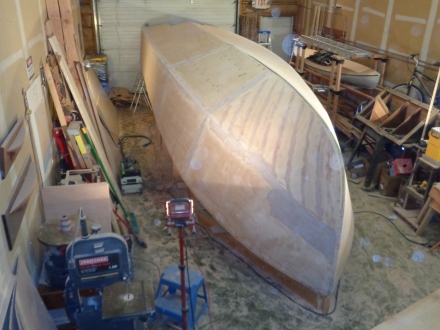
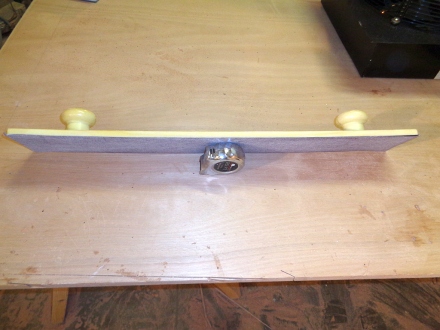
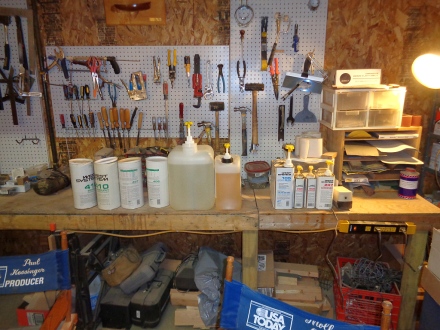
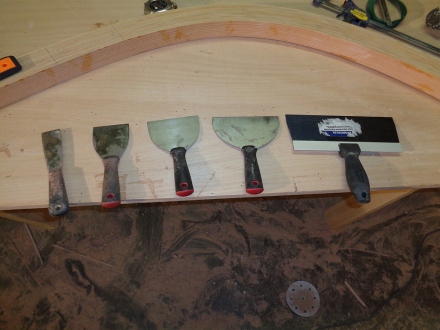
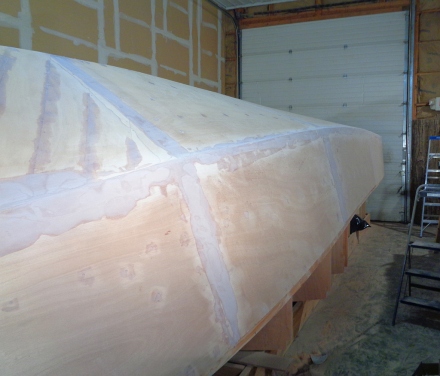
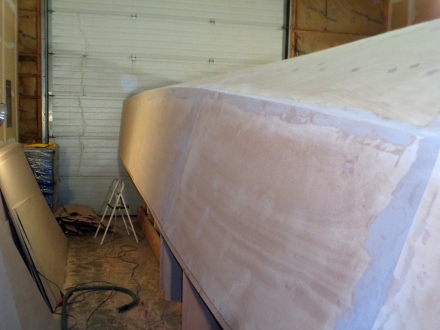

water is liquid,just imagine water flowing around your hull at the designed speeds,the faster the flow the fairer the hull,unless it’s a stepped planing hull or one that requires disrupting of the laminar flow,theTardis doesn’t quite fit those categories,so,”smooth to the hand,fine to the eye”will get you wet sooner,,,,and sooner means more time on the water than”later”,getter wet!!,.R.
LikeLike
Fairing is absolutely the worst part. Glad for you it’s done.
No one will ever examine as critically as you. If you think it’s “pretty good” the dock strollers will surely think it’s fiberglass.
LikeLike
A much easer way to fair is to set up control lines and screed the material using a 1/4 thick x 4″ wide x 4 foot long aluminum screed board. We also use awl grip product called Awl fair. It is Much easer to sand.
LikeLike
Thanks, Scott. If I ever do another big boat I am going to try Awlfair and the Alexseal products. Can’t seem to get the right blend of easy mixing and smoothness with WEST products without a lot of blending. I am going to try Awwood on the bright work.
LikeLike